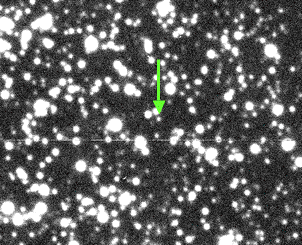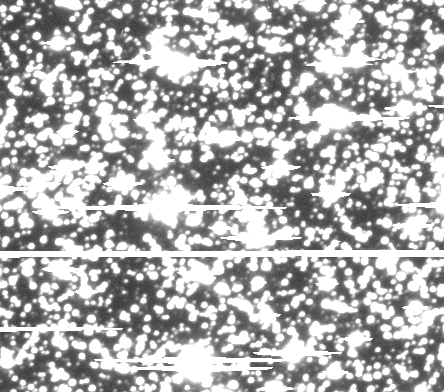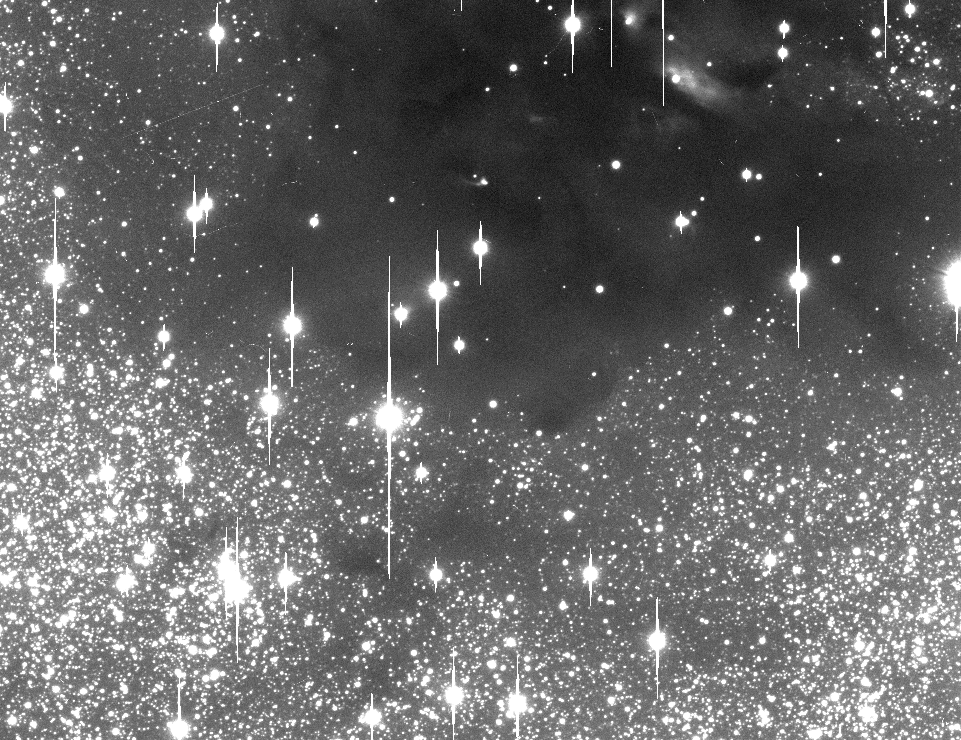Emily Lakdawalla • Aug 13, 2010
2008 LC15, the first Trojan asteroid discovered in Neptune's L5 point
Congratulations to Scott Sheppard and Chad Trujillo for identifying the first known L5 Trojan asteroid of Neptune! This story is not just interesting because it is a first-of-its-kind discovery, but because of the tricky way that the astronomers went about searching for it, and because of the collateral benefits that their search will have for the New Horizons mission. Here's the newly discovered body, a little blip moving against background stars:

I should probably begin by explaining what the heck "L5" and "Trojan asteroid" mean. For a planet in a circular orbit around a star, there exist five positions in space, called the Lagrangian points, where a third body of much smaller mass could maintain its position with respect to the other two bodies. Two of these, L1 and L2, are close to the planet, located closer to the sun than the planet and farther from the sun than the planet, respectively. We use the L1 point (which is between us and the Sun) as a convenient location for solar observing spacecraft like SOHO. We use the L2 point, which is beyond Earth, as a convenient location for spacecraft that look outward, like Herschel and Planck; that's where the James Webb Space Telescope will eventually sit. L3 is on the opposite side of the star from the planet. (For the pedants out there, yes, I know this discussion applies to more general situations than just planets and stars, but I'm trying to help neophytes imagine the physical situation I'm discussing.)

And then there's L4 and L5, which are gravitationally balanced points located 60 degrees ahead and 60 degrees behind the planet in the same orbit, respectively. I'll let Wikipedia attempt to explain to you why this is stable. They're the most stable of the Lagrangian points, and as a result there is a lot of stuff sitting at the L4 and L5 points of many of the big bodies in the solar system. Jupiter is accompanied by a boatload -- several thousand -- of these asteroids, which are referred to as Trojan asteroids (and named, a bit cutely I think, for characters in the Iliad -- the L4 or leading Trojans for the Greeks and the L5 or trailing Trojans for the Trojan characters). None have yet been found in the Saturn or Uranus Lagrangian points, but Neptune was already known to have six bodies in its L4 point. Even some of Saturn's moons have other moons sitting in their L4 and L5 points -- Telesto and Calypso for Tethys and Helene and Polydeuces for Dione.
If Neptune was already known to have six asteroids in its L4 point, why were none known to be in its L5 point before now? It's quite simple: Neptune orbits slowly, and over the past several years while the L4 objects have been discovered, the L5 region for Neptune just happened to be near the plane of the galactic center, making it very difficult to observe. Here's what an image of what the region of space that contains the newly discovered L5 Trojan looked like a couple of years ago:

Yikes! It seems ridiculous to go searching for faint bodies in this region of space. Another thing that doesn't help is that Neptune's L5 region is really huge -- about 1500 square degrees on the sky -- because bodies in stable orbits at L5 may librate up to 30 degrees from the L5 point over time. But Sheppard and Trujillo came up with a tricky plan for locating sparse objects against such a dense star field: they took advantage of naturally occurring dust clouds that obscure part of that star field. The dust clouds are beyond the solar system, so any moving bodies would appear in the foreground, in front of the obscuring dust clouds.

So Sheppard and Trujillo used images from a wide-field sky survey to locate dust clouds, finding 19 square degrees of them in the L5 region. They finally located a single asteroid. Next comes the fun of the statistics of small numbers. If there is one L5 Trojan in 19 square degrees, how many should there be total? They estimate that there should be about 150 -- give 100 or take 200 -- Neptune L5 Trojans brighter than 24th magnitude (which corresponds to a diameter of 80 kilometers). Other statistics of small numbers based on the six known L4 Trojans produced an estimate of 250 give or take 100 L4 Trojans. Within the (admittedly quite large) uncertainties of these small-number statistics, the two numbers match. Which is good news!
Why do we care about Neptune Trojans? First of all, their existence and the characteristics of their orbits (especially, how inclined the orbits are) provide important conditions on models for how the solar system formed -- especially now, when most people seem to agree that the outer planets did not form where they are now, that they migrated into their current positions. Such migration would have brought the giant planets into gravitational interaction with smaller bodies lying in the way; the smaller bodies' orbits are profoundly influenced by the motion, the speed of that motion, and the final positions of the planets. (That's why, for instance, Pluto orbits the Sun twice for every three times Neptune makes the trip; it was shoved into such a resonant orbit by Neptune's migration, much as the Neptune Trojans were picked up and carried into those positions as Neptune moved outward.)
Also, and I thought this was kind of cool, the region of the sky that contains the L5 point of Neptune is the same region of the sky through which New Horizons will travel as it goes beyond Pluto; so searches for bodies in this part of the sky may eventually turn up more distant bodies that New Horizons can visit. No word on whether Sheppard and Trujillo found anything beyond Neptune's orbit yet!
For the curious, here is a table of information about the seven known Neptune Trojans, none of which has been given a more familiar sort of name yet. I've taken this from Table 1 of Sheppard and Trujillo's Science Express paper.
| Name | L | magnitude | diam (km) |
|---|---|---|---|
| 2001 QR322 | L4 | 22.5 | 140 |
| 2004 UP10 | L4 | 23.3 | 100 |
| 2005 TN53 | L4 | 23.7 | 80 |
| 2005 TO74 | L4 | 23.2 | 100 |
| 2006 RJ103 | L4 | 22.0 | 180 |
| 2007 VL305 | L4 | 22.2 | 160 |
| 2008 LC18 | L5 | 23.2 | 100 |
These bodies are not small -- they're 80 to 160 kilometers in diameter. That's comparable to the size of Lutetia, the biggest asteroid yet visited by a spacecraft, and one of the largest bodies in the asteroid belt. There are only a few dozen bodies larger than Lutetia in the asteroid belt, yet Sheppard and Trujillo are estimating something on the order of 400 such bodies accompanying Neptune. There very likely are many much smaller ones too, ones that are too small for us to see from Earth. The lesson here is that these stable points on Neptune's orbit contain a comparable number and size of bodies to what is found in the asteroid belt, maybe even more. Mind-blowing!
As usual, Scott Sheppard has lots more related info about this discovery at his personal website.
Support our core enterprises
Your support powers our mission to explore worlds, find life, and defend Earth. You make all the difference when you make a gift. Give today!
Donate

 Explore Worlds
Explore Worlds Find Life
Find Life Defend Earth
Defend Earth

